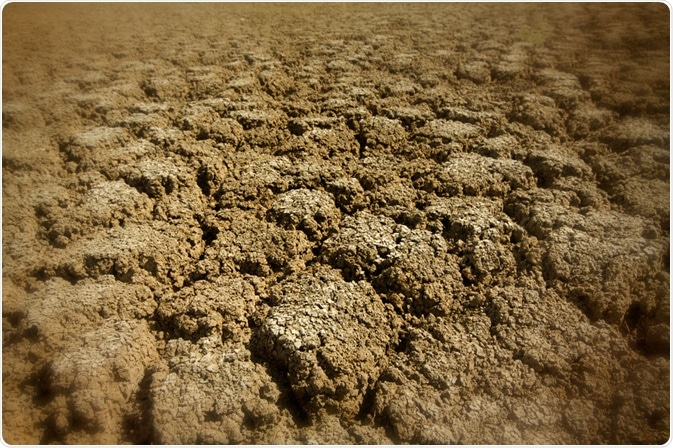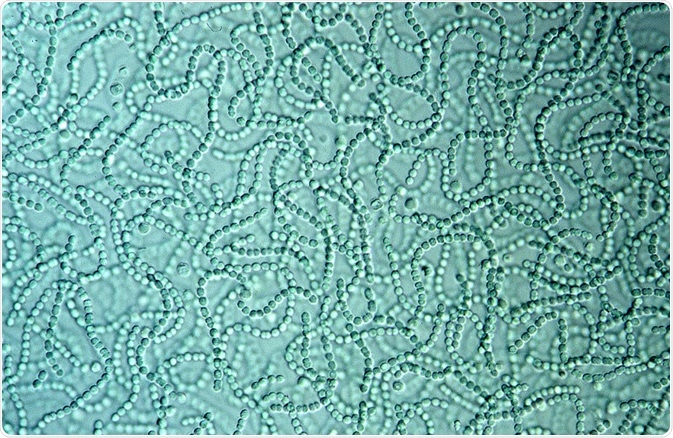Over the past century, extensive agricultural practices such as overuse of fertilizers, and the cultivation of exhaustive crops such as brinjal, sunflowers, etc., have deteriorated the quality of the soil in terms of soil fertility and texture.

Image Credit: Praisaeng/Shutterstock.com
A poor-quality soil would ultimately decrease the quality and quantity of agricultural produce. Thereby, the ever-increasing demand for food supply suffers. This article discusses how microbes could help to restore the degraded soil which would subsequently bring about an enhancement in agricultural production.
Soil degradation and unhealthy agroecosystems are major threats as they would deprive future generations of food security. Healthy natural soil is an incredible mixture of rock-derived minerals, organic matter, dissolved nutrients, and most importantly it contains a plethora of microbes.
Thus, we can say that natural soil is booming with various microbes, i.e., bacteria, fungus, and other organisms. These microscopic organisms interact with each other and perform important tasks such as breaking down complex organic matter (dead plants and animals), nitrogen fixation, phosphate solubilization, production of siderophores, etc. These microbial activities in turn make the soil extremely fertile whereby the agricultural practice thrives without any external use of chemical fertilizers.
The main cause of soil degradation other than industrialization and deforestation is improper agricultural practice. Some such practices are:
- Intensive cultivation
- Unbalanced fertilization
- Poor quality of irrigation
- Usage of chemical fertilizers, herbicides, and pesticides
With the increase in the awareness of the adverse effects of soil degradation, many companies, nonprofit organizations, government agencies, scientists, etc., have started working together to educate the farmers and design means to restore soil health. For example, General Mills is working with the Soil Health Institute and Nature Conservancy to promote farm sustainability by restoring soil health.
Restoring the Fertility of the Degraded Soil using Microbes
As already mentioned above, microbes like actinomycetes, bacteria, fungi, etc., play a vital role in restoring low-quality soil by boosting the availability of essential components such as nitrogen, phosphorous, potassium, and iron to the soil.
Scientists believe that introduction of microbial inocula would be immensely beneficial to the farmers. These would not only reduce the additional expense of chemical pesticides and fertilizers but also boost the quality and quantity of agricultural produce. Some of the direct and indirect mechanisms through which microbes promote soil fertility are discussed below.
Bacterial restoration of degraded soil
Diazotrophs or nitrogen-fixing bacteria can fix nitrogen as ammonia through their metabolic pathways, especially, enzymatic processes. Bacteria belonging to the family Rhizobiaceae, are soil-borne bacteria that commonly infect plant root systems and forms root nodules. These can fix nitrogen which is one of the essential elements for soil fertility.
Some of the microbes associated with nitrogen fixation in the soil are Cyanobacteria, Firmicutes, Proteobacteria, and Archaea. Common nitrogen-fixing bacteria that are either present in the soil or rhizosphere are Azotobacter, Azoarcus, Rhizobia, Azospirillum, etc.
Phosphate solubilization, production of siderophores, organic acids, disease management, and plant hormones like auxin help in plant growth promotion. Several bacteria produce various types of organic acids to solubilize potassium in the soil via various processes such as acidolysis, chelation, etc.
Soil degradation also occurs with the destruction of the soil structure. Soil structure is an important feature of plant development. Many a time, destruction of soil structure entails a decrease in the organic matter or change in the arrangement of individual soil particles. Soil particles are bound together through organic, inorganic, or chemical forces to form aggregates.
Soil aggregates are important for root growth and an array of soil functions. These are also important for various ecosystem processes such as carbon storage and resistance to erosion. In the formation of soil aggregates, some bacteria produce peripheral slime polymers and decompose organic material to form organo-mineral products. These organo-mineral products associate with soil particles to form aggregates.

Image Credit: Dr. Norbert Lange/Shutterstock.com
Fungal restoration of degraded soil
Even though fungi cannot fix atmospheric nitrogen on their own, they provide essential nutrients such as carbon and phosphorous to bacteria who in turn carry out the process of nitrogen fixation. Especially, in moderately degraded soil, arbuscular mycorrhiza fungi fulfill the demand of phosphate required for nitrogenase enzyme that is essential for nitrogen fixation.
Several fungi can increase the bioavailability of potassium, phosphorous, and iron through phosphate solubilization, potassium mobilization via mycelial transport, production of siderophore, plant growth hormones (auxin, gibberellin), organic acid (citrate, malate, and oxalate), etc.
Fungus plays a crucial role in soil aggregation, not only through the production of mucilages, polysaccharides, soil proteins (glomalin and hydrophobins) but also forms a hyphal network that adheres to the soil particles by entrapping them. Funneliformis mosseae, Aspergillus niger, etc., are involved with potassium mobilization, soil aggregation, and the production of various metabolites that aid in soil restoration as well as plant development.
Conclusion
The importance of protecting our soil and its biodiversity is often neglected while spreading awareness of global biodiversity. Healthy soil contains a wide variety of life forms including microbes and tiny insects.
All these organisms, together, bring about immeasurable benefits to life on Earth by mitigating climate change, preventing erosion, storing and purifying water, healthy crop production, etc. Thus, the well-being of plants, human beings, and animals, directly or indirectly, depends on the complex process that takes place in the soil.
Considering the importance of soil, the European Commission proposed a Soil Framework Directive in an attempt to prevent further soil degradation across the European Union and has also taken measures to restore the damage that has already been done.
References and Further Readings
Further Reading
Last Updated: Nov 24, 2020